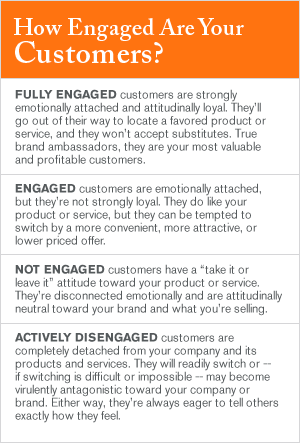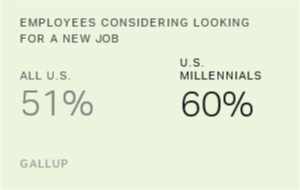It's wrong to intentionally make a promise you can't keep. But it seems that too many companies are making this mistake, and it's hurting their customer relationships. When Gallup surveyed more than 4 million customers, we found that one in five actively disengaged customers feel that the brands they've patronized are breaking promises.
Spending millions of dollars on a commercial during the Super Bowl doesn't create a brand identity.
Your company might not be aware of how your customers feel if you measure only rational attributes like the quality of the product or customers' cognitive attitudes such as likeliness to recommend. Measuring the health of the customer relationship requires a new science that quantifies customers' feelings and levels of emotional engagement.
Making and keeping a brand promise is a complex activity that involves many moving parts, people, and processes. It requires creating an effective brand promise, including a value proposition that reflects the relationships among experience, results, price, and access. It takes a deep understanding of the impact of emotion on customers. And last but not least, it requires aligning important organizational elements to deliver the brand promise, including customer knowledge, strategy, process design, human capital, measurement, and leadership. Get one part of the mix wrong, and the brand promise is compromised. But get it all right, and your brand becomes an engine that drives the company forward.
Creating an effective brand promise
Consumers can recognize a brand in many ways -- a sign, slogan, name, or anything that identifies a product, service, or company. Spending millions of dollars on a commercial during the Super Bowl doesn't create a brand identity; it delivers a brand message. A brand identity is the perception customers have of your company, product, or service and what it represents. But that perception varies because every customer may have a different impression of your brand identity -- and a different experience of how you deliver on your brand promise.
A brand promise defines the integrity of that identity and how well you perform across every customer touchpoint. Active disengagement can occur when brand messaging, customer expectations, and execution aren't aligned. An effectively aligned brand promise can create enough gravitational pull that customers become emotionally engaged with your brand -- and they become fully engaged brand ambassadors.
From working with thousands of businesses all over the world, Gallup finds that an effective brand promise is:
- compelling: The brand fulfills an important and differentiated need in the marketplace.
- connecting: The brand consistently creates an emotional bond with customers that transcends its functional attributes.
- credible: Customers believe that the brand's promise fits the brand's identity.
Examining your value proposition is a good first step in assessing if your brand promise is compelling, connecting, and credible. Your value proposition is determined by the benefits you provide (results and experience) divided by the cost to the customer (price and access) in relation to alternatives (competition). If price is the only rational criterion a customer uses to evaluate your brand's value, then you're driving down a dead-end road of becoming an undifferentiated commodity. Customers have a hard time connecting emotionally to an undifferentiated commodity, and competing on only price and access is a delimiting strategy.
Understanding the impact of emotion on customers
Here's an example that illustrates the relationship between a value proposition and customer emotion. Let's say your car is nearly out of gas, so you drive to a nearby location of the Rational Service Station, which is no better or worse than any other local gas station. It's a mile up the road (access), and you pay $3.80 a gallon (price) for 91-octane gas (results). You go inside to buy a pack of gum from a cashier who flunked charm school, and you use a bathroom that could -- and should -- have been much cleaner (experience).
You got the gasoline you needed, but as a customer, you're definitely unhappy with the experience, and you leave actively disengaged. You made your purchasing decision based on price and convenience because 91-octane gas is the same everywhere, and you probably don't expect a friendly smile or a surgically clean gas station -- at least, not at the Rational Service Station.
Compare that to your purchasing experience when a new location of the Emotional Service Station opens across town. The price of gas is about the same, but this company has figured out how to select employees who genuinely smile while helping customers and spend extra time keeping the store and the restrooms clean. You'll willingly drive across town to the Emotional Service Station because its employees understand that their purpose goes beyond keeping the pumps on and making correct change. It includes engaging customers.
Eventually, the folks at the Rational Service Station may realize they have a customer experience problem when the Emotional Service Station starts stealing market share. Within the context of its value proposition, the Rational Service Station has a fixed location, it can only lower price a slight margin for a short duration, and it will have difficulty convincing customers that its 91-octane is any better than the competition's.
Companies often have no idea what kind of employee is best able to deliver the brand promise.
To get its market share back, the Rational Service Station must change its customers' experience, and of the four value proposition factors, experience is arguably the most difficult to control because it tends to vary so widely. It's comparably easier to change your pricing or location or to invest money in design or R&D to improve your product. It's much harder to change customers' perceptions once they've had a negative experience with your brand.
Aligning your company to deliver your brand promise
To deliver on its brand promise, the first thing a company must do is align all the elements that contribute to an exceptional and differentiated customer experience: customer knowledge, strategy, process design, human capital, measurement, and leadership. These elements are consistent with the well-known Baldrige Criteria for Performance Excellence.
When it comes to human capital, it's perplexing that companies will use far less sophisticated methods for selecting employees than they do for almost anything else. Companies will spend fortunes on facilities, technologies, and advertising, but they often have no idea what kind of employee is best able to deliver the brand promise. Some organizations don't even care. Retail and food service companies are notorious for hiring emotionally disengaged employees and making them the face of the company to customers.
Gallup research shows that most employees struggle to understand their company's brand promise. Fewer than half of managers (46%) and only about a third (37%) of non-management employees strongly agree that they know what their company stands for and what makes their brand different from their competitors, a Gallup study shows. (See graphic "Brand Alignment by Job Role.")

Selecting the right success measures is key because they answer the question "How do you know you're delivering the brand promise?" A brand promise is ultimately measured by what customers and employees think and say about the brand. The most effective success measures are actionable by employees and integrated into the performance management system to ensure accountability.
Herb Kelleher and the importance of leadership
All of these things take leadership. For all of these elements to be aligned and executed well, leaders must really care about the brand -- and therefore, the future of their company. Far too many companies delegate communicating the brand promise to their marketing and training departments. When it comes to helping employees understand and deliver your brand promise, there's no substitute for leaders who "talk the talk" in communicating the promise and who "walk the walk" as role models.
Which brings us to Herb Kelleher, the founder of Southwest Airlines and an exceptionally brand-savvy leader. When Kelleher's ad agency asked him what Southwest stood for, Kelleher said Southwest was all about low airfares. When the agency probed a bit more, Kelleher told them what he wanted Southwest to accomplish: He wanted to make it possible for people to travel; to see the ones they loved; to experience more of the world; and to live richer, fuller lives. But the high cost of airfare made it impossible for most people.
And that, it turned out, was Southwest Airlines' real mission: to "democratize the skies." The agency turned that into the slogan "You're now free to move about the country." Underneath that liberating statement is the company's brand promise -- to provide low-cost, efficient, no-frills flights around the U.S.
It's a brand promise many know, and it has kept its integrity because Southwest keeps everything working together: creating an effective brand promise, including a value proposition that reflects the relationships among experience, results, price, and access; deeply understanding the impact of emotion on customers; and aligning the organization to deliver the brand promise, from customer knowledge, strategy, and process design to human capital, measurement, and leadership.
Any company can put all those elements in place and set them moving. Any company can, but most don't. Operationalizing a brand promise isn't easy and requires a holistic framework to ensure alignment from marketing to each moment of truth. But so much depends on a brand promise. It's a promise a company must keep.
